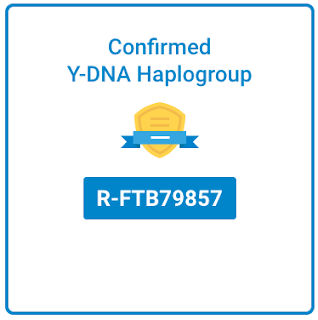R-FTB79857- The Hingerty Haplogroup!
Today (January 18, 2022)
is an historic day for Hingerty family research!
We now have a Hingerty YDNA Haplogroup!
To explain (the quick version):
YDNA is the DNA that only males have. YDNA mutates slowly and is not affected by recombination each generation as autosomalDNA is. YDNA can be traced back in a direct male line back, from son to father to father.... back to the dawn of time when YDNA Adam lived in Africa.
Gradually, groups moved out of Africa, spreading their YDNA signatures across the surface of the earth, following different migration paths and timelines. These broad haplogroups are named by the letters A through to T.
As well as mapping this development of the various haplogroups geographically, this movement and mutation has also been represented as a branching tree, called The Tree of all Mankind.
This tree started out as simple one page poster, but as more and more men have taken YDNA tests, and as the tests have become more and more sophisticated, ever more refined branches of the tree have been discovered and named. The tree now takes up pages and pages and can't be simply represented in a single slide.
From lower level (STR) YDNA testing of a few Hingerty males we knew that 'our' broad haplogroup definition was R. We could track our YDNA further along the branches (downstream) to haplogroup RM269.
This is the most common haplogroup in Western Europe and thus it is shared by our Hingerty males with thousands of other European men. It is dated at 4,000 - 10,000 years old. Interesting, but not very useful for our recent family history.
Recent Big Y700 SNP (the most detailed YDNA testing currently available at FTDNA) testing of two Hingerty males (USA and Australia) has identified an even more downstream/refined haplogroup of R-FTB79857 (also called a family clade).
Indeed, this haplogroup is now named for these two Hingerty men and these two Hingerty men alone!
Haplogroups need at least two testers to share a particular mutation/variation in order for a new haplogroup to be mapped and named.
Thus, at this point in time, we can say that haplogroup R-FTB79857
is the Hingerty haplogroup!
It is estimated to be about 800 years old. So, we know that the USA and the Australian Hingerty shared a common male ancestor in the last 800 years.
FTDNA reports testers Big Y700 results in a number of ways, including what is called the Block Tree- think of it as a family tree stretching back in time only instead of having men's names at the various branching points they list variants/haplogroup labels.
The top of the block tree is far back in time, the bottom is closer in time. Each of those thin blue lines indicate a single tester or group of testers who share the same haplogroup/variants. Our two Hingerty testers are on the far right hand side of the block tree.
Notice on this image of the two Hingerty testers' Big Y Block Tree below, that our current haplogroup of R-FTB79857 is part of a big white block (on the far right hand side of the block tree) which contains eight other variants.
The next task is to break this Hingerty R-FTB79857 haplogroup and block of Variants into even smaller haplogroups- remember we need two testers to share the same variant for that variant to be mapped and named a separate haplogroup/branch.
We await the Big Y700 results from another Australian Hingerty male (results due within the next 2 months)- his results might break up this big white group of Variants a bit more. (All fingers and toes crossed....)
As more Hingerty YDNA testers are added, we would hope that this list of Variants is gradually broken up representing the various Hingerty family lines within genealogical time.
That is our Holy Grail!
Nothing is assured.... we can only live in hope......
Leave a Comment or Send an Email
hingerty@one-name.org







Comments
Post a Comment